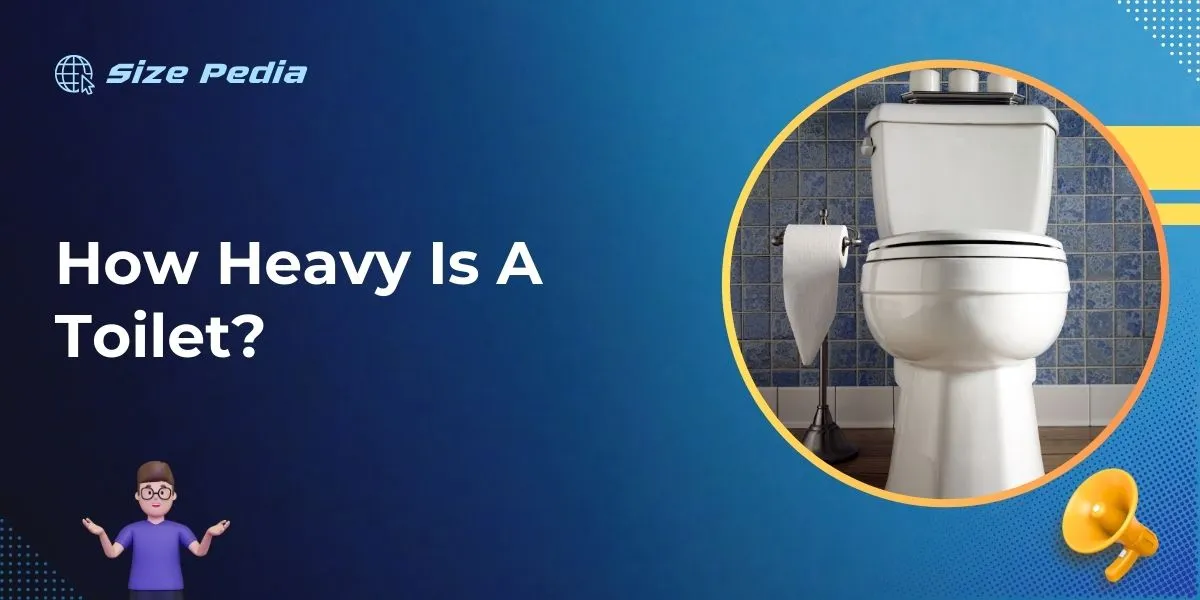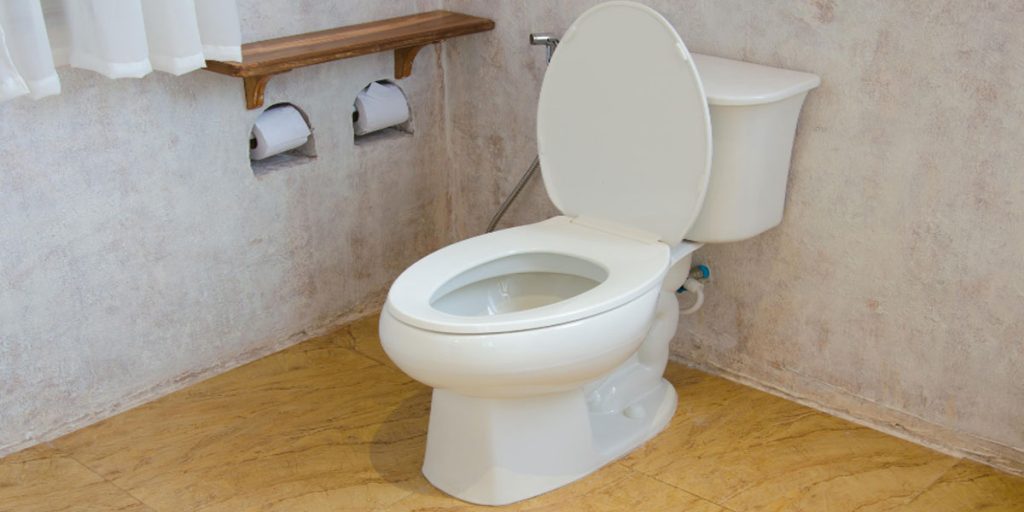A standard toilet weighs about 60 to 120 pounds (27 to 54 kg). Compact toilets are towards the lighter end, while luxury models can be heavier.
Toilets are a fundamental component of any residential or commercial bathroom setup. The weight of a toilet is a crucial consideration during installation, transportation, and for ensuring the appropriate support is in place.
Varying types of toilets, from one-piece designs to two-piece varieties, impact overall weight.
The material is a significant factor too; with the majority made from porcelain, a durable yet heavy ceramic, they can be quite substantial in mass.
For those considering a bathroom remodel or simply curious about the logistics of moving a toilet, understanding the weight plays a part in the planning process.
Selecting the right model requires a balance between functionality, design, and the physical weight your bathroom floor can handle.

How Much Does A Toilet Weigh?
Ever wondered what the weighty facts are behind the bathroom’s porcelain throne? Toilets are everyday essentials, but their heaviness isn’t common knowledge.
From cozy cottages to grand hotels, the weight of a toilet varies widely depending on its type and materials.
Let’s dive into the specifics and uncover just how heavy these bathroom fixtures can be.
Factors Influencing Toilet Weight
Several elements play a role in a toilet’s mass:
- Material: Vitreous china and porcelain are common, influencing weight.
- Type: One-piece or two-piece designs impact the scale.
- Size: Compact models differ in heaviness from elongated ones.
- Features: Additional amenities like bidets add extra pounds.
Average Weight Range For Different Toilet Types
Toilets come in various designs, each with a distinctive weight range:
| Type of Toilet | Average Weight |
|---|---|
| Two-piece | 60-100 pounds |
| One-piece | 80-120 pounds |
| Wall-mounted | 50-110 pounds |
| Smart toilets | Up to 120 pounds |
Remember, these figures are average estimates and can vary by manufacturer and model.
Material Matters: Composition Of Toilets

When choosing a toilet, what it’s made of is key. Toilets are like the silent giants of our homes.
They look alike but differ hugely in weight. Let’s explore the materials that make up these bathroom essentials.
Porcelain Toilets And Their Heft
Porcelain reigns supreme in toilet composition. A mix of clay, minerals, and water, fired at high temperatures, creates a hard, shiny finish. It’s durable.
It’s reliable. Most importantly, it’s heavy. A standard porcelain toilet weighs about 60 to 100 pounds. One-piece models, with seamless designs, tip the scales at the higher end.
Two-piece toilets, with separate tanks and bowls, are easier to handle during installation. They weigh less, but not by much.
Alternative Toilet Materials
Good news: there are lighter options. Alternative materials like stainless steel, fiberglass, and composites offer modern twists to toilet design.
They create toilets that are easier to move and can bring a fresh look to your bathroom.
- Stainless Steel Toilets: These are tough and light. They weigh a mere 30 to 60 pounds.
- Fiberglass and Composites: They bend the scale even less, making them a breeze to shuffle around during bathroom makeovers.
Deciding on the right material matters. It impacts the toilet’s weight, feel, and even the ease of installation. Choose wisely for a throne that suits your home!
Different Seats, Different Scales: Toilet Varieties
Toilet weight can vary greatly. This can impact both the installation process and the support structure needed in a bathroom.
One-piece Vs. Two-piece Toilets
One-piece toilets are a single unit. This means the bowl and tank are fused together. They often weigh more because they’re one solid piece.
A typical one-piece toilet weighs between 80 to 120 pounds.
Two-piece toilets feature a separate bowl and tank. This can make them easier to move and install. The bowl generally weighs 50 to 60 pounds, while the tank is about 20 to 40 pounds.
| Type | Bowl Weight | Tank Weight | Total Approximate Weight |
|---|---|---|---|
| One-Piece | Integrated | 80-120 lbs | |
| Two-Piece | 50-60 lbs | 20-40 lbs | 70-100 lbs |
Wall-hung Toilets: A Lighter Choice?
Wall-hung toilets might seem lighter. They lack a floor-standing tank. The bowl is mounted to the wall with a concealed tank inside the wall.
They typically weigh between 50 to 70 pounds. The weight does not include the in-wall tank and carrier system. A wall-hung toilet can be a space-saving design in smaller bathrooms.
- Weight savings without the tank
- Ease of cleaning under the bowl
- Adjustable height during installation
Installation Implications: Handling Toilet Weight

Considering a new toilet installation brings an important question to mind: How heavy is a toilet?
Indeed, the weight of this essential bathroom fixture has direct implications for how you organize the installation process.
Handling the weight of a toilet is key to ensuring safety and a job well done.
Safety Considerations During Toilet Installation
Safety is paramount when installing a toilet. The average toilet weight varies, but you can expect a range of 60 to 120 pounds.
This makes proper lifting techniques crucial. Here’s how to stay safe:
- Use your legs, not your back, to lift the toilet.
- Wear protective gear like gloves for a good grip.
- If you feel unsure, always have a secondary person to assist.
- Clear the path to the bathroom to avoid obstacles.
Professional Vs. Diy Installation Weigh-in
Choosing between professional or DIY toilet installation involves weighing options. Consider these points:
| Professional Installation | DIY Installation |
|---|---|
| Team lift for heavier toilets | Depend on self or find help |
| Specialized tools on hand | Must prepare necessary tools |
| Expertise in handling toilets | Learn as you go |
| Insured against accidents | Risk rests with you |
Whether you decide on a professional or a DIY approach, understanding the weight logistics is essential.
Always put safety first and plan accordingly to ensure a smooth installation.
The Impact Of Added Features On Toilet Weight
Think toilets are just simple fixtures? Think again. Today’s toilets come with impressive features that influence their weight.
From built-in bidets to high-tech add-ons, these advancements add pounds. Let’s look at how modern features make toilets heavier.
High-tech Toilets: Weight Added By Advanced Features
Modern toilets are not just porcelain thrones; they are central hubs of innovation in the bathroom.
As technology advances, toilets are packing in features that transform the basic nature of these everyday items.
These added functionalities also contribute to an increased weight of the unit. High-tech toilets can include:
- Automatic lids
- Touchless flushing mechanisms
- Self-cleaning systems
- Heated seating
- Motion sensors
Components for these features have definite mass. As a result, a high-tech toilet can weigh substantially more than its traditional counterpart.
It’s not uncommon for tech-equipped toilets to tip the scales at over 100 pounds.
Balancing Function And Weight
Features like bidets are becoming more popular, and they’re often built into toilets, increasing the unit’s overall weight. An integrated bidet adds functions like:
- Warm water spray
- Air drying
- Deodorizing
Manufacturers carefully balance these perks with weight considerations.
Materials like high-density plastics or composite materials are often used to keep the toilet within a manageable weight while still providing robust features and durability.
Typically, a toilet with an integrated bidet system will weigh between 80 and 120 pounds, depending on the complexity and materials used.
Smart toilets push the envelope, boasting all these features and more. They require significant internal hardware, sometimes bringing the weight to around 120 to 150 pounds.
The integration of advanced systems undoubtedly offers luxury and convenience but also demands a sturdier floor support system due to the added heft.
FAQs About the Weight of a Toilet
What Is The Average Weight Of A Toilet?
Standard toilets typically weigh between 60 to 120 pounds. The weight depends on the material and design of the toilet. Two-piece models can be on the heavier side compared to one-piece toilets.
Are Older Toilets Heavier Than Newer Models?
Yes, older toilets can be heavier. They were often built using more materials and thus weigh more. Modern toilets aim for efficiency and may use lighter materials, resulting in a reduced weight.
How Much Do Wall-hung Toilets Weigh?
Wall-hung toilets tend to be lighter, weighing around 50 to 100 pounds. They are designed to be compact and save space, which often translates into less material and weight.
Does Toilet Weight Affect Installation?
Toilet weight can impact installation. Heavier toilets may require more than one person for safe and proper installation. It’s important to consider weight for wall-mounted toilets to ensure wall strength.
Conclusion
Understanding toilet weight is crucial for installation and mobility purposes. On average, toilets weigh between 60-120 pounds, with variations depending on material and design.
Keep the weight in mind when planning a bathroom renovation or a simple replacement to ensure safe and successful handling.
Your back will thank you!
Resources:
https://www.epa.gov/watersense/residential-toilets
https://www.cdc.gov/healthywater/global/sanitation/toilets.html
